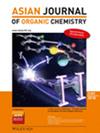salphon -共轭ttf -金属配合物[CuII(TTF-Salphen)]2PF6的合成及物理性质
IF 2.7
4区 化学
Q1 CHEMISTRY, ORGANIC
引用次数: 0
摘要
合成了一种顺磁性金属配合物[CuII(TTF-Salphen)],其中TTF(四硫代fulvalene)配体通过Salphen配位位配位,作为新的π-d体系的潜在候选者。电化学氧化使其阳离子基盐[CuII(TTF-Salphen)]2PF6形成黑色块状晶体。x射线晶体学分析表明,中性配合物和阳离子配合物均具有平面结构,并以头尾方式堆叠形成二聚体。TTF-配合物与[CuII(TTF- salphen)]2PF6中阴离子的2:1化学计量表明TTF部分的部分氧化态为+0.5。[CuII(TTF-Salphen)]2PF6的电导率测量显示其具有半导体性质,反映了其一维柱状结构,其室温电导率为σRT = 1.8 S·cm−1,活化能为Ea = 0.14 eV。[CuII(TTF- salphen)]2PF6在冷却时表现出TTF部分π自旋与Cu(II)中心d自旋之间的弱反铁磁相互作用,在20 K以下TTF部分π自旋形成单重态。对[CuII(TTF-Salphen)]2PF6粉末样品的电子自旋共振(ESR)测量结果支持磁化率测量中观察到的磁性行为。本文章由计算机程序翻译,如有差异,请以英文原文为准。
![Synthesis and Physical Properties of Salphen‐Conjugated TTF‐Metal Complex [CuII(TTF‐Salphen)]2PF6](https://img.booksci.cn/booksciimg/2025-7/108322890891794096487.jpg)
Synthesis and Physical Properties of Salphen‐Conjugated TTF‐Metal Complex [CuII(TTF‐Salphen)]2PF6
A paramagnetic metal complex, [CuII(TTF‐Salphen)], in which a TTF (tetrathiafulvalene) ligand is coordinated through a Salphen coordination site, was synthesized as a potential candidate for a new π‐d system. Electrochemical oxidation afforded its cation radical salt, [CuII(TTF‐Salphen)]2PF6, as black, block‐shaped crystals. X‐ray crystallographic analysis revealed that both the neutral and cationic complexes possess planar structures and stack in a head‐to‐tail manner to form dimers. The 2:1 stoichiometry of the TTF‐complex to the anion in [CuII(TTF‐Salphen)]2PF6 indicates a partial oxidation state of +0.5 for the TTF moiety. Electrical conductivity measurements of [CuII(TTF‐Salphen)]2PF6 revealed semiconducting behavior, reflecting its one‐dimensional columnar structure, yielded a room‐temperature conductivity of σRT = 1.8 S·cm−1 and an activation energy of Ea = 0.14 eV. [CuII(TTF‐Salphen)]2PF6 exhibits weak antiferromagnetic interactions between the π‐spins of the TTF moieties and the d‐spins of Cu(II) centers upon cooling, followed by the formation of singlet states by the π‐spins in the TTF moieties below 20 K. Electron spin resonance (ESR) measurements on the powder sample of [CuII(TTF‐Salphen)]2PF6 support the magnetic behavior observed in the magnetic susceptibility measurements.
求助全文
通过发布文献求助,成功后即可免费获取论文全文。
去求助
来源期刊

Asian Journal of Organic Chemistry
CHEMISTRY, ORGANIC-
CiteScore
4.70
自引率
3.70%
发文量
372
期刊介绍:
Organic chemistry is the fundamental science that stands at the heart of chemistry, biology, and materials science. Research in these areas is vigorous and truly international, with three major regions making almost equal contributions: America, Europe and Asia. Asia now has its own top international organic chemistry journal—the Asian Journal of Organic Chemistry (AsianJOC)
The AsianJOC is designed to be a top-ranked international research journal and publishes primary research as well as critical secondary information from authors across the world. The journal covers organic chemistry in its entirety. Authors and readers come from academia, the chemical industry, and government laboratories.
 求助内容:
求助内容: 应助结果提醒方式:
应助结果提醒方式:


